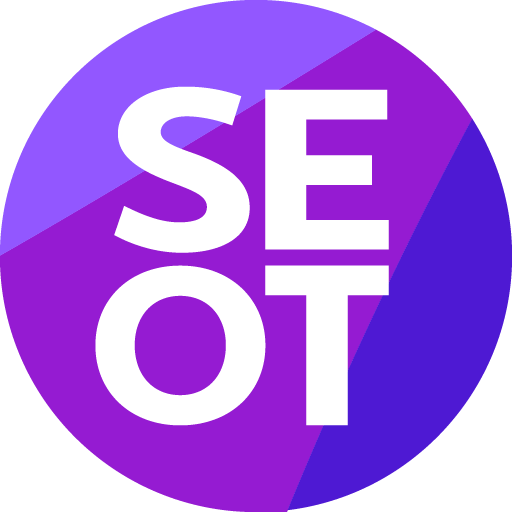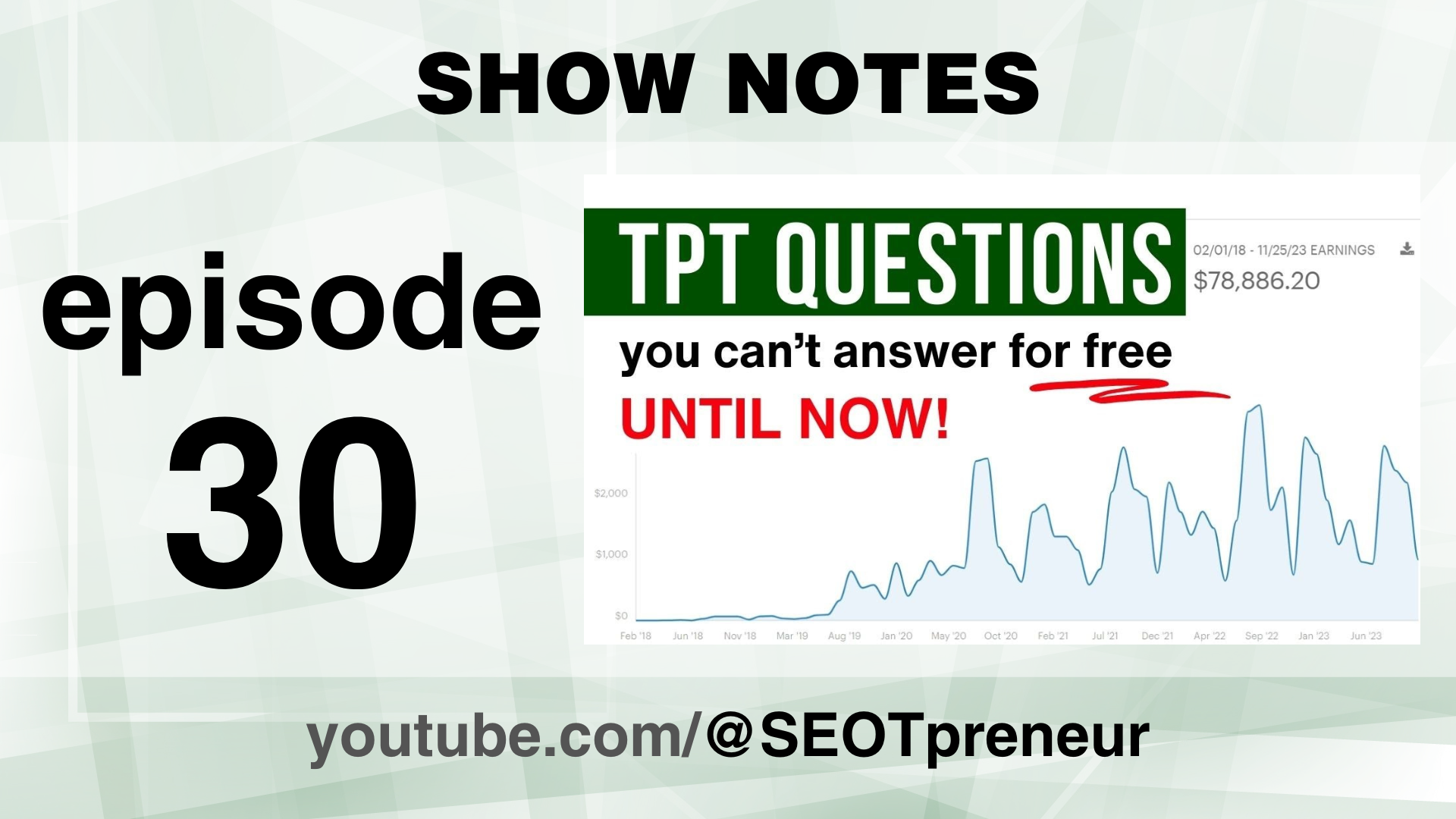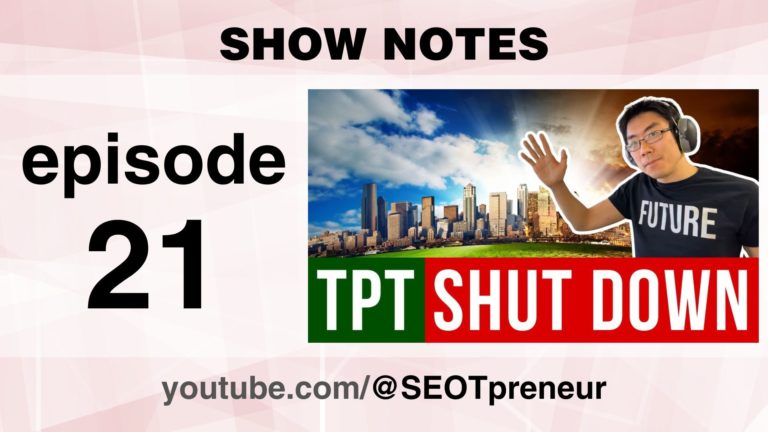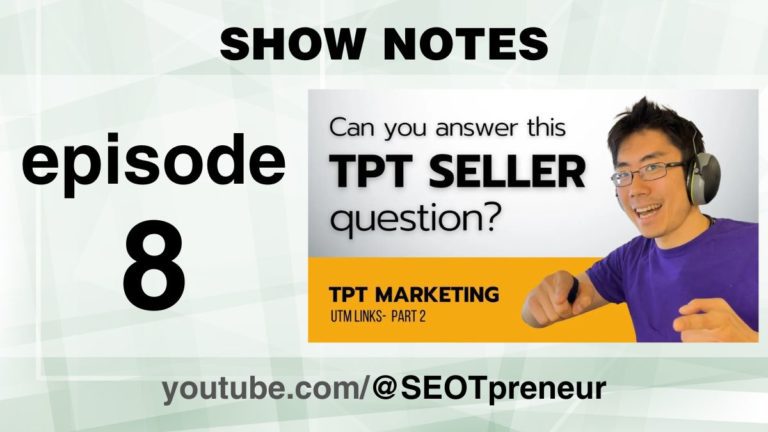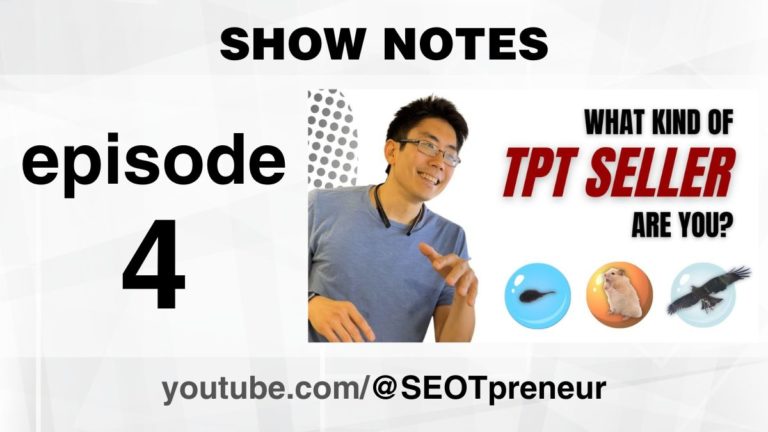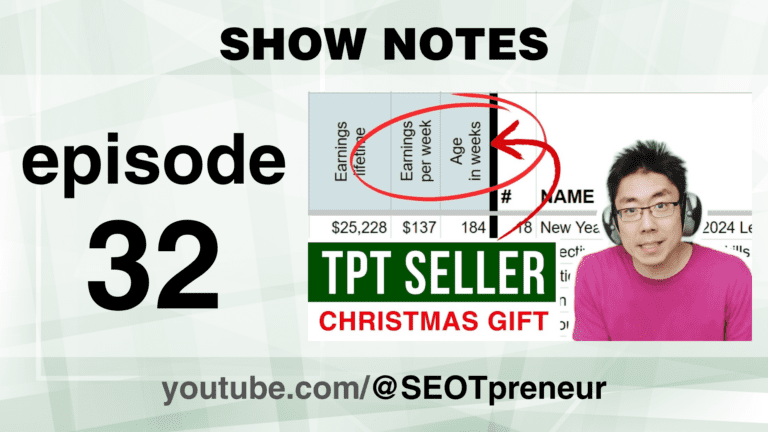Two TPT Questions You Can’t Answer For Free Until Now! – Episode 30
What do teachers buy before they buy your TPT bundles? Do teachers who buy your $1 products ever buy your other higher priced products?
Get the free Google Sheet.
Let’s hang out! Exploding special offer.
Watch the Video
Click here to watch on YouTube.
Questions? Comments? Need Help?
- Any questions? Do you agree or disagree? Challenge my assumptions!
- Need help? Maybe I can provide suggestions!
Say something in the YouTube video comments
VIDEO TABLE of CONTENTS
Transcript
(00:00):
Tab four C is called Magic Filter Related Products. If the person bought the Everything bundle, they also bought all of these resources. Now I’m looking for patterns. Hey, TPT sellers, how are you doing in your TPT business personally, this month I am tanking. I am a thousand dollars, which is about half of what I made last year. So now the question is why am I so excited? It’s not because of sales in my TPT stores. That kind of goes up and down and I know that if I pay attention and crank out what I need to do, once I have my strategy, it’ll get better. I can work on that. No, the reason why I’m super excited is because we just had a fantastic Homework club meeting, and if you’re part of SEOT Premier Pro, you can watch the recording. There was a really good question about how much content should I post for free before I can post a paid resource or post about my stuff.
(00:56):
I’m not talking about Facebook groups. I’m talking about if you have a YouTube channel or a TPT blog. So we talked about what Alex Ozzi talks about in his book, a hundred million dollars Leads and what that magic number is. I am excited because, well, this month I’m not doing that well, but my friend, my TPT seller, I’ve been coaching for a while now, we’re pretty good friends. That person is making way more than I am and they will continue to make way more than I am. After I get past that little pang of like, oh, I’m not doing great. After I get past that, then I start thinking about, well, what are they doing that I’m not? And they’re cranking out products. So that person just mentioned, oh yeah, today I just published a product and three days ago I published a product and I haven’t been grinding away on the hamster wheel as much as I should be.
(01:39):
So I’m excited because last week Andrea was in the homework club and we were talking about things and from that came the idea about, well, why don’t we open up a coworking space? And so every day this week I’ve been in the coworking space grinding away on my TPT product, and sometimes there are other SEOT there, and it’s very cool because even though they’re not watching me because I can see their avatar or whatever in Zoom, I know that we’re working on TP together. It’s kind of like a marketing party. So yeah, it’s gotten me closer to getting my product out the door, and I know that if I crank out more products and I have a strategy that I’m going to do with my products, then eventually I will get better and I just have to get on that hamster wheel. Last week on Rika and I were thinking about her dollar products and we were trying to figure out whether or not they actually lead to more sales or do they lead to bundles or do people buy only dollar stuff products?
(02:35):
And I was Tinkering away with her and she was watching me as I was Tinkering away in one of our Zoom chats and I couldn’t crack the code but Enrika today, an hour ago, I cracked the code and the update is live. So for context, Wrike pointed out a fantastic point here. Basically the idea is, well, if you drop your product down for a dollar, then you attract people who want a dollar resource and then they want resources that only cost a dollar and then they don’t buy other stuff. So you’re just attracting people who want cheap low price resources. Later on this week, maybe at the next live stream with Enrika, we’ll use the latest update of this Google Sheet tool and see if we can answer that question. But read re’s comment, it was on the episode about freeways to advertise your TPT store.
(03:21):
So watch masterclass number six, it explains how to use the free solid tool or to get your data, I’m just going to confirm my subscription to get the tool, I’m going to make a forced copy of the latest version, which is November 25th. Give it a second to load. I’m going to switch to the bottom tab here, a TPT sales data CSV, click in the yellow box. Now I’ve already exported my old data from a free seller tool and I’m just going to paste it in here. So I go file, import, I click on upload, I have it, here’s the file here, and I’ve updated the files. I redacted the buyer names into generic person IDs and I’ll explain more in a second. Replace data at sell, import the data. Now some of you have way more data than I do to the point that it’s filling up this Google sheet and then you have to copy that last month, sell in column X.
(04:14):
So I imagine that your Google Sheet file might run a lot slower than mine, so just be aware of that. I’m going to delete this top row. I’m just going to gorl down just to make sure there’s no ending thing here and I know it’s good because I have this month thing all the way to the side. Okay, here’s the exciting part. I call it the magic filter. Click on the three all sheets icon there and I’m going to go to four a magic filter, which is very boring. There’s nothing to see here. I click on the edit and what I can do now is I can filter it to find people who buy a specific product. Why haven’t everything bundle where it includes everything, all of my resources on TPT. So there’s my Everything bundle. I’m going to show just everything bundle, and now I have a list of people who bought Everything Bundle.
(05:00):
Now my list, I’ve redacted my buyer name. So if I open up my sales data, and if I just expand this button, you can see I have person one, person two, person three, person four, and that’s just for privacy reasons. But in your data you’ll have actual people names. Let’s go back here to the magic filter. So I have here, if I scroll down here to the bottom, I should have, it says row 46, but the top row is a buyer row. So this should be 45 people who bought this resource. And if I check in TPT, here’s my Everything resource, and if I click on units sold, I see that there are 45 people. So it’s good to double check the data that’s in the Google Sheet tool with what you’re actually getting from TPT because data gets confusing. So you want to just double check these things.
(05:46):
So I know that this number looks correct, these look like they’re people who bought the resource. Now I’m going to go to tab four B, which is Magic Filter Sales. This tab now pulls up only the people who bought Everything bundle. For example, if I go back to the magic filter list, I can see that at the top here, person five bought Everything bundle, and I see here Person five bought a number of my different resources, and if I go control F to just show you and I look for everything bundle, it’s highlighted in green and there is person five, they bought everything bundle there. Okay, so here’s where the cool stuff is, and I call it magic because I mean it’s magical. If you don’t understand the mechanism, then it seems like magic. So magic tab four C is called Magic Filter related products.
(06:33):
If the person bought Everything bundle, they also bought all of these resources. Now I’m looking for patterns like, okay, well actually it doesn’t really look like people are buying a number of resources. I don’t know if people are buying a lot of resources and then buying Everything bundle, or do they buy everything bundle straight? I know that. Look, here’s interesting, this vocabulary building handout. It seems to people this is count of your earnings. It’s how many people actually bought it. I’m looking for patterns here like okay, look, if they buy the reading strategy mega bundle, then sometimes that upsells, here’s my SEOT resource. I see some goal setting stuff here. So maybe they bought the goal setting stuff, but this helps me in terms of my product descriptions. If they buy this, they might also be interested in that and that, let me sort of think about big picture, upsell communication marketing.
(07:28):
Here’s where the magic is four D, the magic filter buyer story. So this is showing me the person and when they bought different resources for me. So when Enrika and I look at her data on Tuesday, we’ll be able to see, okay, here’s where they bought the Dollar Store resource. Did they buy any other resources or are they only dollar store resources? So I can see that this person five, and this is sorted by, if I go to the very end here, this is sorted by the customer lifetime value. So person five I find interesting. If I want to see what they bought, I can click on this plus sign and it’ll expand and show me all of the resources. I still have this search for everything. So I can see it shows up in green here. This person in 2018, they bought this character growth Mindset bundle, but then they bought it again in August.
(08:19):
Doesn’t that seem weird? If they have it, how can they possibly buy it again? Alright, here’s the magic of pivot tables. If I double click the number, it’ll open up that sales data from my TPT sales reserve. So here’s the person that ignore 43. That’s row 43 in the CSV person five from this place. They bought one unit at 5 99. Okay, well what’s the second one then? How could they possibly buy it Again, if I go to this person here and click on 3 45, I see that they didn’t buy it at full price, they bought an additional license here, so that makes sense. That’s how they could buy the same resource twice, which means that this person, wow, that’s kind of cool. So rather than just sharing the resource, they did the legit thing, which was buying the second license. Not everyone does that. I want to connect with this person.
(09:11):
I have no way of knowing who they are because we don’t have their contact information and that is what it is. That’s the business model of TPT. I would love to connect with them, but I can’t. If I look back at this person, if I look at the way that they bought the products leading up to Everything bundle, let’s say the goal was to sell Everything bundle. Well, what kind of resources do they buy? I’m looking for patterns. They bought this character building Growth mindset and then they bought this other 60 resource about citizenship, and then this is a year apart. So first year, and then the second year they bought a second license and another resource. And then in September they bought Growth Mindset bundle posters, and then they bought that collaboration resource and then they bought Work Smarter. So I can see that they’re buying their resources, they’re buying the sixties kind of resources.
(09:55):
Then in 2020, a year later, they bought communication and creativity. They bought the SEOT Growth Mindset or the goal setting bundle. They bought fund citizenship debates. So they bought the sixties bundle. And at this point, I wish I could email them to say, if you bought the Sixes bundle, which includes all of those resources, you probably would save money and you could get a refund on products that are included in bundles as long as it’s purchased within a year. That’s what the TPT policy is. I’m not TPT, this isn’t legal advice. Obviously you have to check with TPT, but I have no way of communicating with them about, Hey, you can save money or can I give you a refund on those resources and just have you connect to that bundle. So I see what they bought here, and then here in 2022, they bought this Everything bundle, which was 85 91, which in theory, they could have gone a refund for other things, but it’s not showing up in here.
(10:49):
You’re going to ask like, Hey, what if they got a refund? Maybe it should show up here. If it did, it would show up as a negative number because it shows up as a separate line item in our TPT sale CSV number. So I can see their process, their path here, they bought this resource here, I want to connect with them because that’s actually included in Everything bundle. But I have no way of communicating with this person. And then I can see here in 2023, now I have to figure out how do I make my communication more clear so that people, I like to think of it as it’s not a problem with the system. How can I improve my communication process to overcome this issue? And so maybe what it is is just sending out in my newsletters, Hey, if you bought the Everything Bundle, make sure that you get a refund for stuff that you bought 12 months before that.
(11:38):
I can help you with that. Email me kind of stuff. But I love this. I can dig in here and see the path that people make. Here’s everything Bundle. So if the price goes up, because TPT used to Force Force the discount that we could do. So it’s interesting, can see people are buying Everything Bundle. I’m looking to see if they bought everything in the column before and a good chunk of people are not. This person bought everything bundle at 91 80 and then they bought another resource in October, and I wish I could could contact them because that would’ve been included in what it is, is because I think the reading comprehension strategy shows up as a bundle. So even though everything bundle includes all the resources, if they look at a separate bundle that they haven’t purchased, it shows us as if they don’t own it.
(12:26):
And after this, I’m going to put a suggestion to TPT, because if you buy one bundle that includes the products within another bundle, I think they shouldn’t, I dunno, that seems kind of sneaky, that it doesn’t make it clear, Hey, you already own these resources. So that’s an idea. But TPTs a growing platform, and as TPT sellers, we can give feedback, but that’s it. That’s the magic filter buyer story. So with a matter of clicks, you can quickly see which products people buy. If they buy Product X, here’s a list of product Y that they also buy. And you can see in terms of time what products people are buying before they buy that bundle or whatever it is that you are looking for. If you have any questions like, I wish I could do this with the data, is there a way that we can make the Google Sheet tool answer this kind of question?
(13:17):
Ask it in the YouTube comments. I love answering general questions. If you want to ask a specific question about your store, now is the time there is a special, I think I called it. Just start and we’ll figure things out later. Kind of sale. There’s a 50% sale into getting into SEOT Printer Pro and in SEOT Printer Pro. Oh, that’s not actually the discount code. Don’t use that code. If I go to SEOT printer.com, if I scroll down here to this post, let’s hang out. Exploding special offer. No squirrels were harmed in the making of this offer, but there’s a special link here that will work until the end of the TPT sale. That will get you 50% off. And once you’re part of the club, once you’re part of SST Pro, I’m happy to look at specific questions about your TPT store, your TPT data, your TPT blog. Just post it in the forums and I’m happy to help you out, especially with Google Sheets, because Google Sheets is not easy for everyone. Have a fantastic weekend. Good luck with your TPT sales, and I will see you next week.
